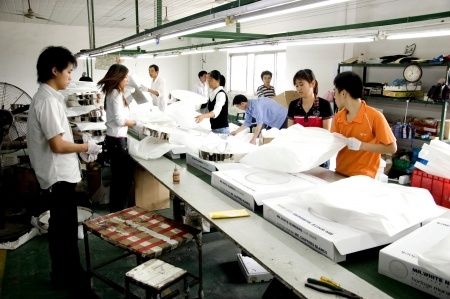 The body's digestive system works something like a reverse assembly line. |
Have you ever seen a car or other object being made by an assembly line? The object is passed from person to person, with each person completing their own job before passing it on to the next. The body's digestive system works a little bit like an assembly line—but in reverse. Instead of building something from parts, the body's digestive system breaks food down into parts. These parts, called nutrients, can be used by the body to make energy.
Digestion is defined as this breakdown of food into smaller parts. Digestion can be either mechanical, in which food is physically torn apart, or chemical, in which food is broken into smaller parts through chemical reactions. Some parts of the digestive system perform mechanical digestion, some perform chemical digestion, and some perform both.
Chemical digestion is accomplished through enzymes. Recall that enzymes are biological catalysts. A catalyst is a substance that speeds up a chemical reaction. So, as biological catalysts, enzymes speed up chemical reactions that take place in the body. During digestion, enzymes speed up the chemical reactions that break food into smaller parts.
The drawing below shows the main parts of the digestive system.
!["Blausen 0316 DigestiveSystem" by BruceBlaus. (When using this image in external sources it can be cited as:Blausen.com staff.) Own work. Licensed under Creative Commons Attribution 3.0 (http://creativecommons.org/licenses/by/3.0/) via Wikimedia Commons]](https://s3.amazonaws.com/cms.accelerate-ed.com/image/429afe3a-bfa8-4826-880f-452ed92e42f4.png)
The mouth, pharynx, esophagus, stomach, small intestine, large intestine, and anus all form a continuous tube through which food enters and waste leaves. This tube is also called the digestive tract. The salivary glands, liver, gallbladder, and pancreas are called accessory glands and organs because they are not part of the tract, but they serve the digestive system in other ways. As you go through this lesson, you'll learn how the components of the digestive tract and the accessory glands and organs function.
Before you move on in the lesson, see if you can identify which structures are accessory organs and glands and which structures make up the digestive tract. Drag each term to its correct category.
| Digestive Tract |
Accessory Organs |
Accessory Glands |
|
|
|
|
|
mouth
pancreas
salivary glands
esophagus
stomach
gallbladder
liver
intestines
anus
|
||